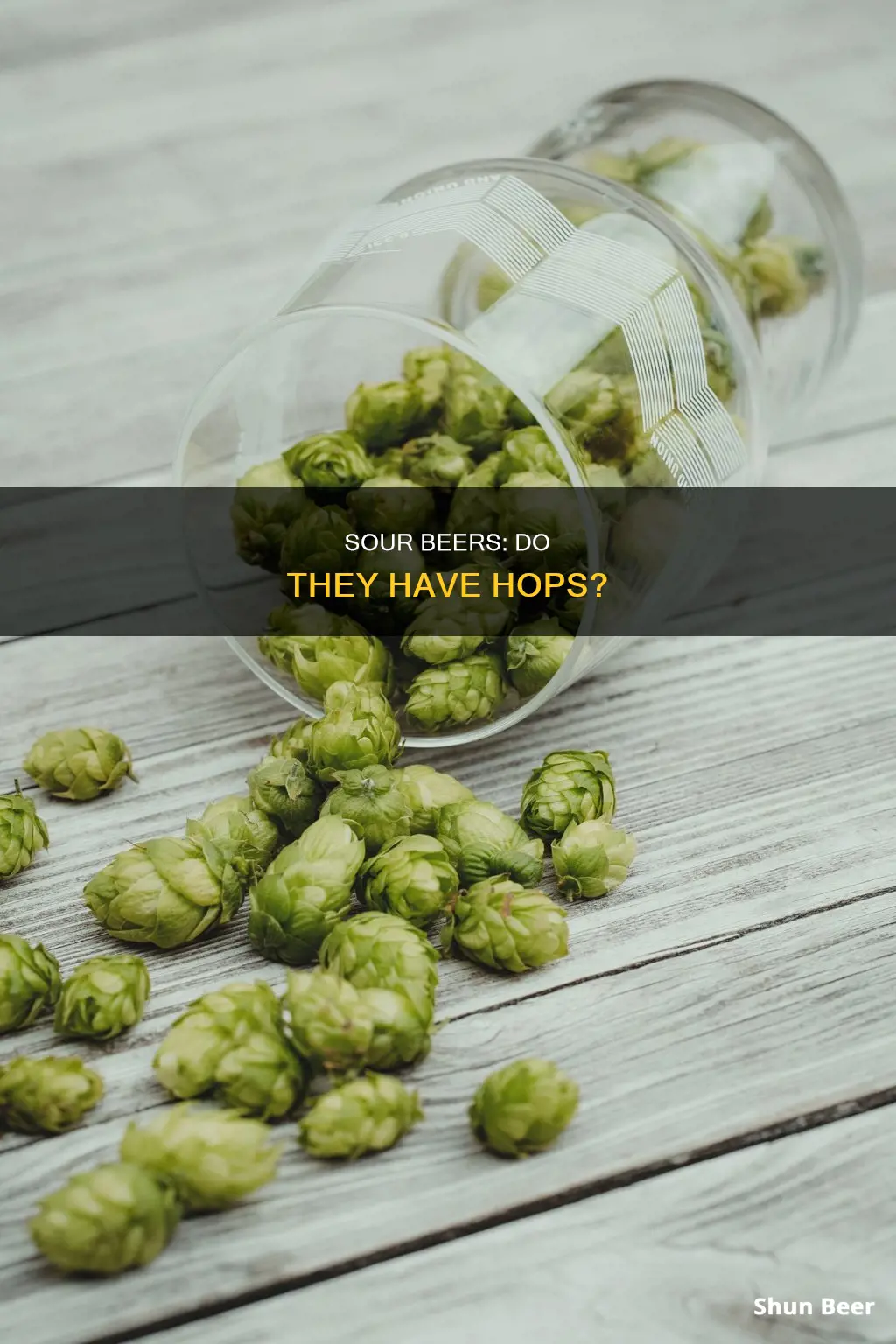
Hops are indeed used in the brewing of sour beers, but their role is quite different from that in other beers. In sour beers, hops are used to provide other acids in a supporting role rather than bitterness. This is because the bitterness from hops can clash with the acidity in a sour beer. Brewers of sour beers deliberately use hops that are aged one to three years in a warm environment. As the hops oxidise, they lose their sharper bitterness and gain some smoother bitterness, creating a nicer finished profile in the beer.
What You'll Learn

Hops are not necessary for sour beers
Sour beers use organic acids produced during the fermentation process to balance malt sweetness. In this way, the flavor profile of many sour beers is similar to wine, in which natural acidity from grapes balances both residual sugar and perceived ester sweetness.
While hops are not necessary, there are examples of beers in which a combination of bitterness and souring do taste good together. Gueuze, a style blended from lambics of differing ages, is one such example. Barrel-aged stock ales which have been left to sour are another style of beer that can combine bitterness and souring in a pleasant way.
Brewers who do choose to use hops in sour beers are encouraged to use old hops. Belgian brewers who make sour beers deliberately use hops that are aged one to three years in a warm environment. As the hops oxidize, they lose the sharper bitterness from the alpha acids and gain some of the smoother bitterness of the beta acids. This makes for a nicer finished profile in the beer.
Hemp and Hops: Exploring the Botanical Cousins
You may want to see also

Hops are used to prevent lactobacillus growth
Hops are used to prevent the growth of Lactobacillus in beer. Lactobacillus is a genus of bacteria, specifically Gram-positive lactic-acid-producing bacteria, that is often used to sour beers. However, Lactobacillus is quite sensitive to hop compounds. Isomerized alpha acids found in hops prevent Lactobacillus from reproducing by damaging their cell membranes. Therefore, hops are used to prevent the growth of Lactobacillus and thus act as a "protective" power in beer.
While there are some moderately hop-tolerant Lactobacillus strains, it is recommended to keep the IBUs (International Bitterness Units, a way of measuring alpha-acid in beer) below 5 if souring beer with Lactobacillus. At this low amount, there is hardly a reason to add any bittering hops. Brewers, even lambic brewers, will thus avoid using high-alpha hops such as Simcoe, Chinook, Cascade, and Amarillo when making sour beers. Instead, they may use aged hops, which have lost their alpha acid bitterness, to achieve the desired aged-hop flavor.
Hops Beer: The Secret Behind the Bitter Buzz
You may want to see also

Sour beers use a saccharomyces strain first
Sour beers are fermented using a variety of yeast and bacteria. The yeast responsible for fermenting all clean beers is Saccharomyces, which is also used in sour beer production. Saccharomyces is a fast-working, highly IBU-tolerant yeast that acts as a base yeast for sour beer production. It is the single genus of yeast responsible for fermenting all clean beers.
Saccharomyces, commonly known as brewer's yeast, is used in the first step of the sour beer fermentation process. It is responsible for the greatest portion of gravity reduction and alcohol production in nearly all sour beers. There isn't any wrong strain of brewer's yeast that will ruin your beer, just some strains that work better with certain types of sour beers.
Saccharomyces is used in the first step of the sour beer fermentation process because it is a robust yeast that can be relied on to produce a healthy fermentation. It is also used because it produces glycerol, a compound that provides a significant amount of the overall viscosity and body in both beers and wines.
The use of Saccharomyces in the first step of the sour beer fermentation process also has benefits in terms of flavour. The combination of Saccharomyces with other yeast and bacteria can yield a wider variety of potential flavours than the other yeast and bacteria may be able to create on their own. This is because many of the flavour molecules produced by Saccharomyces will later be transformed into new compounds by the other yeast and bacteria used in the fermentation process.
Therefore, the inclusion of Saccharomyces in the first step of the sour beer fermentation process increases the overall complexity of the beer.
Hops' Preservative Powers: Keeping Beer Fresh
You may want to see also

Aged hops lose their alpha acid bitterness
Hops are indeed used in the production of sour beers, but they are typically aged. The ageing process reduces the bitterness of hops, which is caused by alpha acids.
Alpha acids (α acids) are chemical compounds found in the Humulus lupulus (or hop) plant. They are present in the resin glands of the flowers of the hop plant. The alpha acid content of hops is measured in a laboratory, and the ASBC method for doing so involves several reagents and a spectrophotometer. The alpha acid "rating" on hops indicates the amount of alpha acid as a percentage of the total weight of the hop. Hops with a higher alpha acid content will contribute more bitterness.
Over time, hops lose their alpha acids, and therefore their bitterness. Proper handling can slow the degradation of alpha acids, but even properly stored hops gradually lose bitterness. The rate of loss is influenced by the temperature at which the hops are stored. For example, US-grown Northern Brewer hops stored at 68 °F (20 °C) retain 70–85% of their alpha acids after 6 months, but this figure drops to 4.4–6.5% after a year. However, if stored in a freezer at 41 °F (5 °C), the retention rate after a year is predicted to be 77%.
The ageing of hops is a deliberate strategy employed by brewers of sour beers. Belgian brewers, for instance, use hops that are aged for one to three years in a warm environment. The hops will initially smell "funky" and then "cheesy", before eventually losing all aroma. They will also lose their alpha acid bitterness, which is the desired outcome. As the hops oxidise, they lose the sharper bitterness from the alpha acids and gain some of the smoother bitterness of the beta acids. This results in a nicer finished profile in the beer.
Grow Your Own Hops for Beer: A Step-by-Step Guide
You may want to see also

Hops can be added to sours for aroma and flavour
The hops used in sour beers are typically aged for one to three years in a warm environment. During this time, the hops will first smell "funky", then smell "cheesy", and eventually lose all aroma. This ageing process also causes the hops to lose their alpha acid bitterness, which is desirable in sour beers as it reduces the risk of the hops clashing with the acidity of the beer.
When adding hops to a sour beer, brewers must be careful not to add too much bitterness, as this can conflict with the sourness of the beer. Instead, the goal is to deliver hop aromatics without much associated bitterness. This can be achieved by using low alpha acid hops, adding the hops late in the boil, or using a process called "dry hopping", where hops are added to the beer after fermentation.
Dry hopping is a popular method for adding hops to sour beers, as it allows the hops to contribute floral, herbal, piney, or citrus aromas and flavours without adding bitterness. These hop additions can enhance certain characteristics produced by Brettanomyces fermentations, such as earthy aromas, wet hay, grass, or flavours of mango, pineapple, and other tropical fruits.
When choosing hops for a sour beer, it is generally recommended to use noble hop varieties, as these tend to be a safe bet. Newer American hop varieties such as Simcoe, Amarillo, and Citra can also work well, especially in sour beers without significant amounts of caramelized malt.
While adding hops to a sour beer can be a great way to experiment and create unique flavour profiles, it is important to note that sour beers are typically aged for long periods, and the hop character will diminish over time. Therefore, sour beers with hops are best served fresh, as the hop character will begin to decline within three to six months.
Hops: Brewing Demand and Future Growth
You may want to see also
Frequently asked questions
Yes, hops can clash with the acidity in sour beers. Hops are added during the boiling process to balance the sweetness of the malt, but the bitterness they add can clash with the acidity in a sour beer.
Sour beers require hops with low alpha acid varieties to reduce the bitterness. Belgian brewers who make sour beers deliberately use hops that are aged one to three years in a warm environment.
Yes, there are some popular sour beers that include hops. For example, the New Belgium Le Terroir, The Rare Barrel Egregious, and Crooked Stave Hop Savant all include hops.
There are a few different methods for adding hops to a sour beer. One method is to add hops during the boiling process, another is to dry hop the beer after fermentation, and a third option is to blend a sour beer with a hoppy beer.







